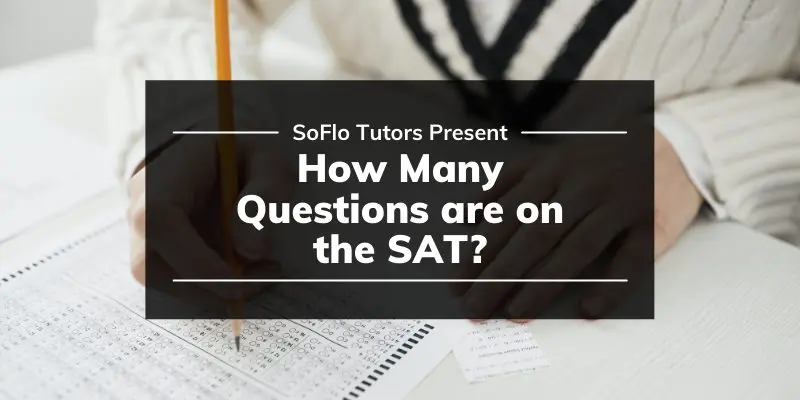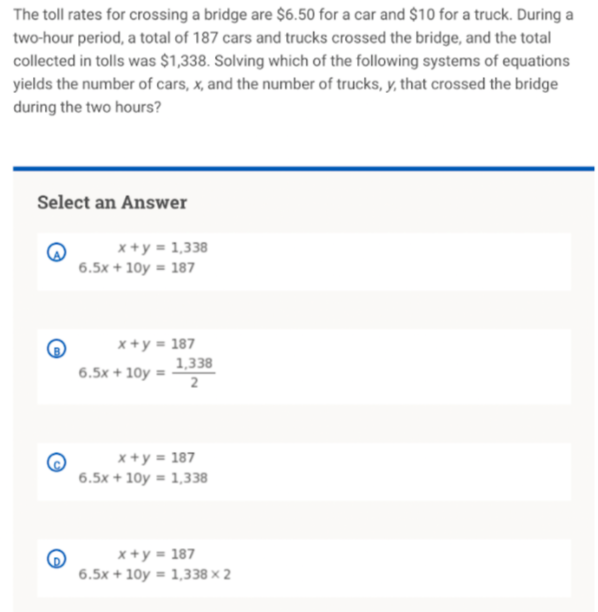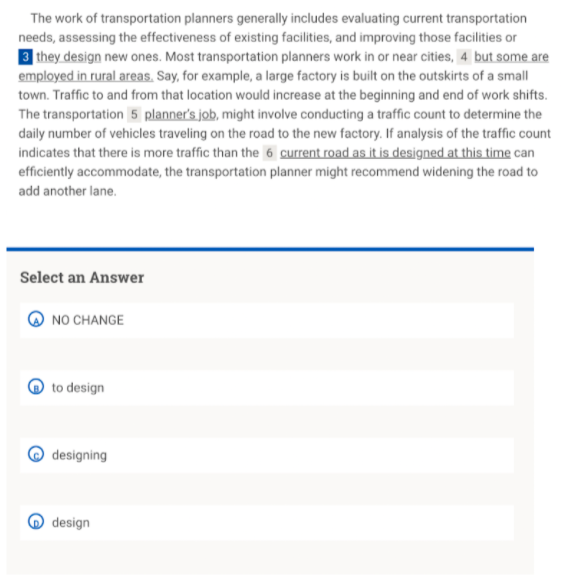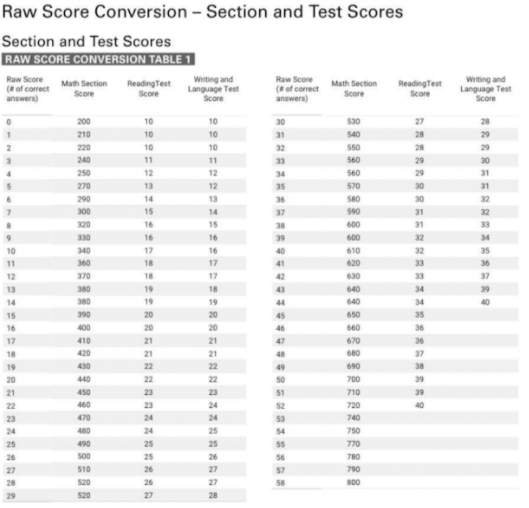
How Many Questions is the SAT Test
The SAT test consists of 154 total questions.
These questions are spread among three broad categories including Evidence-based Reading, Math, and Writing & Language.
The Reading test involves 52 total multiple-choice items spread across 5 different reading passages. The Writing & Language test contains 4 passage sets accompanied by around 11 questions per passage for a total of 44 multiple-choice questions. The Math test includes 45 multiple-choice and 13 grid-in questions for a total of 58 items divided into a no calculator and a calculator section.
There is also an optional essay section for the SAT, but it is currently in the process of being discontinued. The optional essay is only available in states where it’s required as a part of a certain school curriculum.
The 180 minute length does not include breaks, meaning test day will last longer than just three hours. SAT practice tests will also contain 154 total questions and the format will also stay the same. However, for practice tests, it’s up to the student to time themselves and mimic the time requirements for each section. On SAT test dates, a proctor will be in charge of enforcing time limits.
How Long is the SAT?
The four sections of the SAT are tested in the order of Reading, Writing & Language, Math (with calculator), Math (no calculator). The last aspect of the test would be the optional essay section, although the College Board barely administers the essay anymore.
The total time for the SAT is 180 minutes, made up of 65 minutes on the Reading, 35 minutes for the Writing & Language, and 80 minutes for the Math. The Math category is broken down into 55 minutes for the calculator portion and 25 minutes for the no calculator portion. There are 50 minutes given for the optional essay, which does not contribute to the overall SAT time.
The 180 minute length does not include breaks. There are also a couple of breaks during the exam. The first break is after the Reading test and is 10 minutes long. There is also a 5 minute break in between the two Math tests. If you are taking the SAT Essay, you are given an additional 2 minute break after the math test.
How Many Questions are on the SAT: Each Section Breakdown
Evidence-Based Reading
The SAT reading section consists of 5 passages, each followed by around 10 questions pertaining to the information in the passage. The 5 passages consist of one classic or contemporary piece of literature, one U.S. historical passage, a social science section, and two physical science passages. The historical paper usually contains text from a U.S. founding document or text from the Great Global Conversation, such as a famous speech. The social science piece concerns topics such as psychology, economics, or sociology. Lastly, the two science passages survey foundational notions and progression in earth science, biology, chemistry, or physics. This section contains 52 questions in 65 minutes, meaning that there is approximately one minute per question if a student takes 2 minutes to read each of the 5 passages.
Types of Reading Questions to Expect on the SAT
Each of the 5 passages involve different types of followup questions that target different literary techniques. Each passage involves the test taker to shift their focus to different aspects of the text and to assess the questions from different perspectives. Included below are different themes to follow for each passage type:
| Passage Type | Focus | Questions to ask | Sample Question |
| Literary Narrative | Theme Tone Author’s intent Sensory Descriptions | Who are the characters and what are their relationships to one another? What is the setting of the narrative and why is it relevant? Is the narrative told in the perspective of a narrator speaking about himself? | The passage suggests that the character believes the main idea of the story to be important because… |
| Historical Passage (Paired) | Comparison between the passages Difference in author intent Difference in tone or point of view | What is each author’s main viewpoint or opinion? What would be one author’s response to the other passage? | How would one best describe the relationship between passage one and passage two? |
| Social Science | Tone Bias Purpose Author’s Intent | What is the purpose of this passage? What is the thesis or main argument? What is the author trying to convince you of, or trying to conclude? | Which statement would the author most likely agree with? |
| Natural Sciences | Theories Discoveries Hypotheses Research methods Data Expert remarks Graphics | What was the scientific method used? How was data obtained? What was the hypothesis and the result? | According to the graph, was variable A’s relationship with variable B beneficial or destructive? |
Math Section
The SAT math section is divided into two subsections: math with calculator and math without calculator. Technically, both sections should be able to be completed without the use of a calculator, however, a calculator is only permitted on the “with calculator” section and may help students save time and work efficiently through the questions.
The other unique aspect of the math section is that it isn’t entirely multiple choice. There are “grid-in” questions that are essentially “fill-in the blank” at the end of both math subsections and make up 22% of the questions on the math test. This test allows 80 minutes for 58 questions, meaning that there is about a minute and 20 seconds allotted for each question.
Types of Math Questions to Expect on the SAT
The focus of the math section curriculum is algebra, including linear equations and systems; problem solving and data analysis, which involve word problems and quantitative literature; and advanced math, which feature complex equations including geometry and trigonometry. The math section will not go as far as calculus, but will test at subjects that are below the pre-calculus level.
It’s extremely important to learn the heart of algebra, which the College Board uses to assess if students are able to understand algebraic concepts like linear functions and solving for unknown variables. Most SAT prep books and tutoring services will go over the math curriculum, which includes a host of different topics including percentages, ratios, and test your understanding of graphs (which the College Board calls the passport to advanced math).
Example Question

Correct answer: C.) x + y = 187; 6.5x + 10y = 1,338
Answer choice C is correct because the variable x represents cars and the variable y represents trucks, and we need to create a system of equations in order to isolate one of the variables to solve. The total number of vehicles that crossed the bridge during the two hour span should be represented by x + y, and set equal to that number, 187. 6.5x + 10y represents the price per vehicle type and is set equal to the total amount of money collected by the combination of the two for a total price of 1,338, which the equation is set equal to.
There will be several problems on the SAT that resemble the question above in terms of setting up the answer to an equation without actually being asked to solve it. However, in other questions, you might be asked to fully solve the equation so that you have an answer for both x and y.
Writing & Language
The writing test is all multiple choice and focuses on finding and fixing mistakes within passages.
The test purely assesses language skills, but does not require any previous knowledge on any of the written topics. The language acquisition abilities that will be tested on include command of evidence, words in context, analysis of history and science, expression of ideas, and standard English conventions. This section provides 35 minutes for 44 multiple-choice questions, so there is only around 48 seconds per question allowed for this section.
While you might think this section would be easy, you should still study specifically for it because of the short time constraint per question. Performing well on the language section can be especially helpful in the admissions process if you’re interested in studying the humanities once you enroll in college classes.
Types of Writing & Language Questions to Expect on the SAT
As mentioned above, there are several topics covered in this section. On a broad spectrum, questions concern argumentative claims and supporting details to the passage; questions involving style, tone, and syntax of the text; editorial decisions relating to improving the flow and grammatical correctness of passages; questions relating to structural changes and ways in which to make words fit better together; and standard grammatical structure questions. The grammatical structures often involve verb tense, subject-verb agreement, number agreement (plural-plural or singular-singular), punctuation and comma use, and parallel structure.
Example Question

Correct answer: C.) Designing
C is the correct choice because it matches the parallel structure of other verbs within the paragraph such as “evaluating” and “assessing”, so the word “designing” would maintain the same verb tense.
On the SAT writing test, there will be many problems that look identical to the one above in that there will be an underlined word in a passage and a question that asks for the best replacement options for that word. Most often, a set of answer choices for a question in the writing section will contain “NO CHANGE” as the answer A option.
How is the Overall SAT Score Calculated?
Although the SAT is broken up into four sections, it is only scored based on two categories: the overall math section and a combination of the Evidence-Based Reading and Writing section.
Both of these categories are scored on a scale of 200-800, meaning that the maximum composite score for the SAT is a 1600. Each component is originally given a raw score, which is just the number of correct answers tallied in a question set, and is then converted into a scaled score. The SAT does not count against incorrect answers, meaning that there is no score deduction if you answer a question wrong; you can only benefit from guessing if you do not know an answer.
For both the Reading and Writing sections, the raw score is translated to a number between 10-40. Because the overall score for these sections is a combination of Reading and Writing, the sum of the two individual scores will range from 20-80, which is then multiplied by 10 to provide a scaled score between 200-800. The math score is the combination of the no calculator and calculator subsection for the same score range. When all sections are combined, you are given a composite score range from 400-800.

How Many Questions on the SAT Can You Get Wrong?
Although the exact raw score conversions can vary, there is a typical range in which you can expect to score based on the number of questions you answer correctly in a section.
Typically, if you get 0-1 questions wrong on the combined math section you will expect to score a perfect 800.
If you miss 1-3 questions on math, you lose around 10 points and score a 790. However, if you miss 10 questions on the math section, you can expect to score in the 680-710 range. Missing 20 on this section would result in a score of around 600.
Similarly, if you miss 1 problem on both the Reading and Writing & Language tests, you might score a 780 for the combined Reading and Writing scored section. Missing 10 questions on both of these subsections would result in a combined score ranging from ~640 to ~660. Missing 20 on each of these subsections would translate to a score around 530 – 550.
Essentially, you can miss quite a few problems while still scoring relatively well. For example, if you missed 20 questions on the Math section and the 20 questions on the Writing and Reading subsections, you can still score in the 1130 – 1150 range, which is fairly competitive. An 1150 usually ranks around the 67th percentile nationally, meaning that even if you missed 60 questions out of the 154 total questions on the SAT (conventionally a 61% on a standard scoring scale), you can still score better than 67% of people taking the SAT test.
For everyone, especially those who need extremely high scores for their college admissions goals, minimizing the number of questions you miss is the obvious key for every section; again, while guessing on some standardized tests in high school might lead to score penalties, you should always guess on SAT questions you aren’t sure about. Leaving questions blank and unanswered will hurt your score and get in the way of reaching your goal.
To gain a better understanding of your test scores, looking at your percentile will help you determine how well you are doing based off of your personal college admissions goals. The College Board will also provide a score report that will give insight into what type of test questions you missed and whether they were in the SAT Reading test or SAT math test portion.
Get the Maximum of Your SAT Preparation with SoFlo SAT Tutoring
One way to increase your readiness and preparation for the SAT is through tutoring.
Familiarizing yourself with the content and layout of the exam can substantially elevate preparedness and success on the test. SoFlo SAT Tutoring offers test prep services from high scoring students who attend top universities. Our online tutors have proven their mastery in the subject and provide individualized attention to other students.
Check out our tutoring services and schedule a free SAT consultation to get started today and begin the journey to improving your own scores.
Sources
- https://collegereadiness.collegeboard.org/sat/inside-the-test/reading
- https://collegereadiness.collegeboard.org/sat/inside-the-test/math
- https://collegereadiness.collegeboard.org/sat/inside-the-test/writing-language
- https://collegereadiness.collegeboard.org/sat/inside-the-test/sat-test-description
- https://blog.collegeboard.org/how-long-does-the-sat-take
- https://collegereadiness.collegeboard.org/about/alignment/math/heart-of-algebra
- https://collegereadiness.collegeboard.org/about/alignment/math/passport-to-advanced-math
Additional SAT Resources
- How Long is Each Section of the SAT?: https://soflotutors.com/blog/how-long-is-each-sat-section/
- How to Cram for the SAT: https://soflotutors.com/blog/how-to-cram-for-the-sat/
- How to Master Geometry on the SAT: https://soflotutors.com/blog/how-to-master-geometry-on-the-sat/
- Can You Retake the SAT? How Many Times Can I Retake the SAT?: https://soflotutors.com/blog/retake-sat/
- SAT Crash Courses | How to Cram for the SAT: https://soflotutors.com/blog/sat-crash-course/
About the Author

Catie Mullin is a sophomore at the University of Southern California studying Psychology. She is an expert tutor with SoFlo Tutoring and scored a 33 on her ACT. While she’s from Boise, Idaho, she was actually born in Germany!









